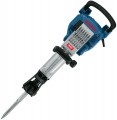Chuck size
The nominal size of the SDS Hex chuck (see Chuck Type) installed in the demolition hammer.
The larger the cartridge, the heavier the tool, usually, and the more complex and voluminous the work for which it was created. The minimum SDS Hex size in modern demolition hammers is 10mm, the same as SDS+; accordingly, similar mounts are found in light class models (see "Weight"). And in heavy professional units, the cartridge size can exceed 30 mm.
Noise level
The noise level produced by a demolition hammer during operation. The lower the noise, the more comfortable the instrument will be to use. However, it must be said that this parameter is quite approximate: the actual noise level depends on the specific mode of operation, the nozzle used, the material being processed, etc. Nevertheless, the indicators claimed in the characteristics make it quite possible to evaluate the overall “loudness” of the instrument – for example, in order to choose the appropriate noise protection means.
When evaluating the noise level, you need to keep in mind that the decibel is a non-linear quantity. Therefore, it is easiest to use comparative tables for evaluation. Here is a simplified version of a similar table for the noise range covered by modern demolition hammers:
75 dB — loud scream at a distance of 1 m;
80 dB — ringing of a mechanical alarm clock at a distance of 1 m;
85 dB — motorcycle engine with muffler in close proximity;
90 dB — freight car at a distance of 7 – 10 m;
95 dB — noise in the subway car on the stage;
100 dB — industrial shop;
105 dB — mid-range home theater at full volume.
Weight
The total weight of the tool — usually, without taking into account the installed nozzle.
In the case of demolition hammers, weight depends not only and not so much on the comfort of holding in hands, but on specialization. The specifics of the work carried out by this tool is such that a large weight is often an advantage, not a disadvantage. Therefore, modern demolition hammers are conventionally divided into three "weight categories":
— Lightweight — models weighing up to 6 – 7 kg. Designed mainly for work on vertical surfaces, when the tool has to be held on weight.
— Medium — up to 10 – 12 kg. Used primarily for horizontal surfaces.
— Heavy — up to 30 kg or more. They are used in road works, when laying the foundation and for other similar tasks where high power and productivity are required.

